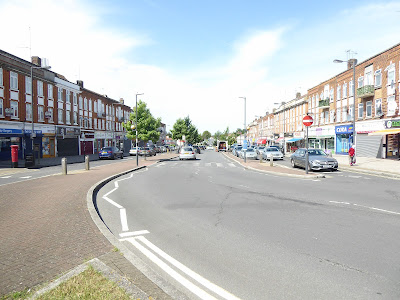Only Jubilee line trains come through the station and there are just the two platforms.
The station exit is in the middle of a small shopping parade. The Underground signs to the right and left of the station have the large U and D on the sign. These signs first appeared on promotional material from 1908 when the various different underground railway companies agreed to use the word 'UndergrounD' for all joint promotions.
Across the road from the station is a public green space developed in the 1930s as was the rest of this area. The roundel with the mast and shelter is an attractive feature. I read that this might be a Charles Holden design but I can't verify that although it is similar to masts and roundels decorating some of the stations he designed.
Another small parade of shops run alongside the Green.
It didn't take me long to look around Queensbury. The station is only 1.3km or 0.8ml from the previous station so I am only looking at a small area that I've not visited. It is mainly made up of wide, tree lined, residential roads and roundabouts.

After a couple more residential roads and roundabouts I came to a wide road with lots of shops, Mollison Way which looked a little more interesting but not much.
This Tesco Express store used to be the Flying Eagle Pub. Not sure when it closed down but you can still see signs of its heritage. Walking along the road I came across a number of these Heritage Trail information boards.
The road is named after the test pilot Jim Mollison. Jim was the husband of pilot Amy Johnson who learnt to fly at Stag Lane aerodrome and went on to break many aviation distance records in the 1930s including the first woman to fly solo from Britain to Australia. She piloted a de Havilland Gipsy Moth from Croydon to Darwin. The aircraft is now on display at the London Science Museum.





















So it looks like typical suburbia with few historic buildings. The roads look wide and clean.
ReplyDeleteNice story about de Havilland. And all that what is now Londen. Wonderful.
ReplyDeleteVery suburban place, never knew about the De Havilland Link
ReplyDeleteA suburb which is very 1930s. Boring, but has sufficient shops to enable survival. The History is good, well doen for finding that. Interesting that the name was simply to match the King!
ReplyDeleteThat's interesting about the UndergrounD. I had not heard that before. I wonder if it is seen elsewhere.
ReplyDeleteHmm, most tourist don't stop at Darwin but fly on to Sydney or Melbourne. Amy missed out.
Only two stations to go on the Jubilee Line. There must be a celebration upon completion.
Another interesting journey through parts of London I have not visited, nor probably ever will. It seems such a shame that the grand old pub was converted to a supermarket, but I guess that's what is known as "progress" by some. The story about De Havilland was very enlightening.
ReplyDelete"Queensbury" sounds so romantic and historical -- a surprise it was less interesting than most all of your stops (partly I'm sure because it was so close to the next one where you'd already written about). And your exploration here was definitely one of the shortest walks you've ever done!
ReplyDeleteLove those old planes and the noise they make when they fly is so high pitched and almost squealing.
ReplyDeletewhat a neat little place!! and the aviation history is really cool!!!
ReplyDelete